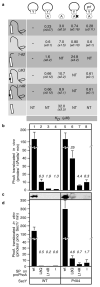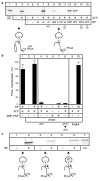Signal peptides are allosteric activators of the protein translocase
- PMID: 19924216
- PMCID: PMC2823582
- DOI: 10.1038/nature08559
Signal peptides are allosteric activators of the protein translocase
Abstract
Extra-cytoplasmic polypeptides are usually synthesized as 'preproteins' carrying amino-terminal, cleavable signal peptides and secreted across membranes by translocases. The main bacterial translocase comprises the SecYEG protein-conducting channel and the peripheral ATPase motor SecA. Most proteins destined for the periplasm and beyond are exported post-translationally by SecA. Preprotein targeting to SecA is thought to involve signal peptides and chaperones like SecB. Here we show that signal peptides have a new role beyond targeting: they are essential allosteric activators of the translocase. On docking on their binding groove on SecA, signal peptides act in trans to drive three successive states: first, 'triggering' that drives the translocase to a lower activation energy state; second, 'trapping' that engages non-native preprotein mature domains docked with high affinity on the secretion apparatus; and third, 'secretion' during which trapped mature domains undergo several turnovers of translocation in segments. A significant contribution by mature domains renders signal peptides less critical in bacterial secretory protein targeting than currently assumed. Rather, it is their function as allosteric activators of the translocase that renders signal peptides essential for protein secretion. A role for signal peptides and targeting sequences as allosteric activators may be universal in protein translocases.
Figures




References
-
- Rapoport TA. Protein translocation across the eukaryotic endoplasmic reticulum and bacterial plasma membranes. Nature. 2007;450:663–669. - PubMed
-
- Papanikou E, Karamanou S, Economou A. Bacterial protein secretion through the translocase nanomachine. Nature reviews. 2007;5:839–851. - PubMed
-
- Hartl FU, Lecker S, Schiebel E, Hendrick JP, Wickner W. The binding cascade of SecB to SecA to SecY/E mediates preprotein targeting to the E. coli plasma membrane. Cell. 1990;63:269–279. - PubMed
Publication types
MeSH terms
Substances
Grants and funding
LinkOut - more resources
Full Text Sources
Molecular Biology Databases

